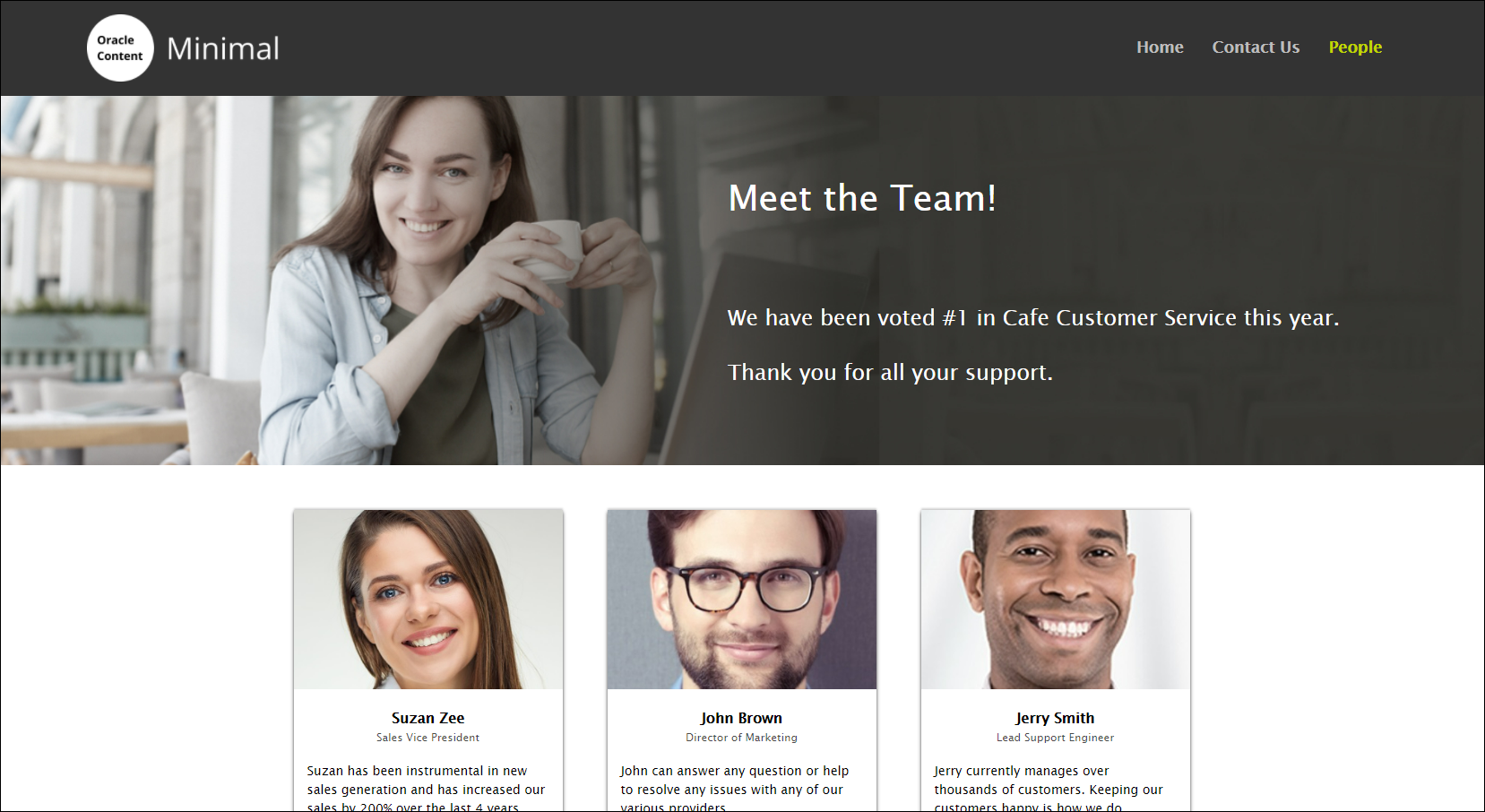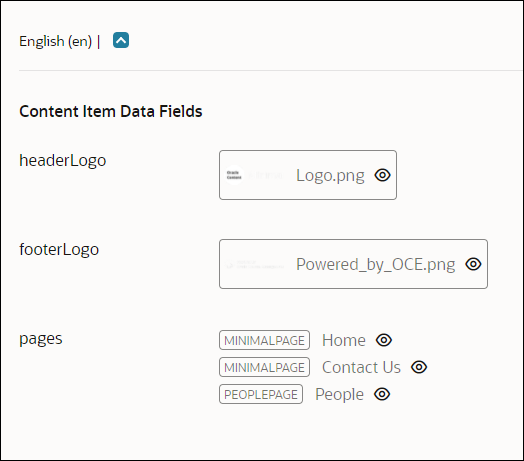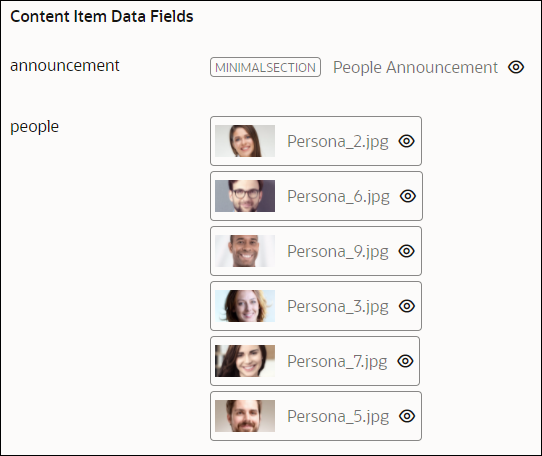将 GraphQL 与 Vue 和 Oracle Content Management 结合使用
简介
GraphQL 是 API 的查询语言,也是使用现有数据执行这些查询的运行时。
在本教程中,我们将介绍如何将 GraphQL 与 Vue 连接至 Oracle Content Management。特别是,我们将通过使用 GraphQL 查询所需数据,重点关注最少示例站点上的现有“人员”页。其他页面(“Home(主页)”和“Contact Us(与我们联系)”)当前使用的是 REST API。
先决条件
在继续本教程之前,我们建议您先阅读以下信息:
要学习本教程,您需要:
- Oracle Content Management 订阅
- 具有内容管理员角色的 Oracle Content Management 账户
- 完成的在 Vue 中构建最少站点的教程
我们正在构建的内容
使用 Vue 中内置的最少站点,您可以轻松地从 Oracle Content Management 资料档案库检索图像和其他内容。
要查看我们正在构建的内容,教程的结束状态是使用 Oracle Content Management 中的内容的基本 Vue 最少站点:
https://headless.mycontentdemo.com/samples/oce-vue-minimal-sample
本教程将仅重点介绍该网站的“人员”页面。
以下是本教程结尾的人员页:

要继续,您需要有效订阅 Oracle Content Management 并使用内容管理员角色登录。
任务 1:了解人员页分类
可下载资产包包含一个名为 Minimal Main GraphQL 且带有 slug ‘ minimalmaingraphql ’ 的资产。
Minimal Main GraphQL 资产包含名为“人员”的 PeoplePage 类型的页面。内容如下所示:

人员资产的类型为 PeoplePage,它包含人员的子类型。内容如下所示:

以下是 people 资产示例的外观(请注意“属性”面板中的所有元数据):

任务 2:与 Vue 中的 GraphQL 接口
本教程的初衷是使用 vue-apollo 库在 Oracle Content Management GraphQL 接口与 Vue 最小样例应用程序之间提供方便的接口。遗憾的是,编写此样例时,vue-apollo 实现仅可用于 Vue 2.x 应用程序,而最小 Vue 样例使用 Vue 3.x。正在努力支持 Vue 3 中的 apollo,但在创建此样本时它仍处于字母级别开发阶段。因此,此样例是使用交叉提取编写的,该库为服务器端和客户端使用提供提取实现。由于 GraphQL 查询最终只是一个 POST 请求,因此这仍然有效,但需要比 vue-apollo 实现更低级别的数据操作。
现有应用程序布局
数据检索
最初的 Vue 示例使用 REST 调用填充两页:主页和通过唯一的拖动值引用的动态页。这两个页面都包含一个或多个表示要在页面上呈现的 HTML 块的“部分”条目。由于此公用布局,两个页面都可以使用相同的页面模板 Page.vue 来显示其数据。要添加到示例中的“人员”页面的结构非常相似,但基于使用 GraphQL 检索的数据构建。
页面路由
使用 Vue Router 扩展处理应用程序中页面的路由。这样,就可以将页面分成两个特殊情况:主页和唯一拖动值引用的任意数量的页面。这样,只需在应用程序的主要资产中添加对子页面的引用,然后按上述方式定义人员资产,就可以向应用程序添加更多子页面。
VueX 状态管理
页面中显示的所有数据都使用 VueX 存储进行管理。这负责调用用于检索每个页面内容的内容 SDK。
包括 GraphQL 支持的更新
安装相关性
第一步是安装 GraphQL 支持所需的库。我们需要安装跨提取来提供浏览器和服务器端网络访问以及 https-proxy-agent,以便在需要时提供代理支持。这是通过运行以下命令完成的:
npm install cross-fetch https-proxy-agent添加新代码以运行 GraphQL 查询
然后,我们创建一个名为 src/scripts/graphql-service.js 的新文件。此文件将执行 GraphQL 查询,然后从结果中提取有用的字段。这是通过创建交叉提取查询来对 Oracle Content Management 进行 POST 调用来完成的。GraphQL 数据在 POST 调用的主体中传递。
export default async function fetchPeopleData(peopleSlug) {
try {
const channelToken = `${process.env.CHANNEL_TOKEN}`;
const fetchParams = {
method: 'POST',
headers: {
'Content-Type': 'application/json',
},
body: JSON.stringify({
query: `
{
getPeoplePage(slug: "${peopleSlug}", channelToken: "${channelToken}" ) {
id
slug
name
fields {
announcement {
id
fields {
type: fieldType
heading
body
actions
image {
...sectionImages
}
}
}
people {
id
fields {
fullname
title
biodata
file {
metadata {
width
height
}
}
renditions {
name
format
file {
url
metadata {
height
width
}
}
}
}
}
}
}
}
fragment sectionImages on image {
id
fields {
file {
metadata {
width
height
}
}
renditions {
name
format
file {
url
metadata {
height
width
}
}
}
}
}
`,
}),
};
// Figure out if we need a proxy. Only needed on server-side render
if (typeof window === 'undefined' && typeof process === 'object') {
const proxyServer = process.env.SERVER_URL.startsWith('https')
? process.env.oce_https_proxy : process.env.oce_https_proxy;
if (proxyServer) {
const proxy = createHttpsProxyAgent(proxyServer);
fetchParams.agent = proxy;
}
}
const response = await fetch(`${process.env.SERVER_URL}/content/published/api/v1.1/graphql`, fetchParams);
const queryResult = await response.json();
return extractRequiredPeopleFields(queryResult);
} catch (error) {
console.log(error);
return ('');
}
}还有一个小实用程序函数,用于简化从调用返回的 JavaScript 对象。这样可以减少结果中不必要的数据嵌套。
function extractRequiredPeopleFields(queryResult) {
const result = { announcement: {}, people: [] };
result.slug = queryResult.data.getPeoplePage.slug;
result.name = queryResult.data.getPeoplePage.name;
const base = queryResult.data.getPeoplePage.fields;
if (base.announcement) {
result.announcement = base.announcement.fields;
}
if (base.people) {
result.people = base.people;
}
return result;
}在 VueX Store 中集成查询代码
现在我们可以检索数据,下一步是将其放在应用程序用来管理其数据的 VueX 存储中。这是在 src/vuex/index.js 中通过添加以下实用程序函数和存储实现的:
state.peoplePageData // storage for the object data
// get the data for the People Page given its slug
fetchPeoplePage({ commit }, pageSlug) {
return fetchPeopleData(pageSlug).then((data) => {
commit('setPeoplePageData', data);
});
},
// setter function used to update the state
setPeoplePageData(state, data) {
state.peoplePageData = data;
},分支代码以呈现“人员”页
接下来,我们将创建集成点,应用程序可以在其中调用代码来呈现“人员”页面。通过修改 Page.vue 中的现有代码,可以根据 slug 值有条件地呈现。可以在 src/pages/Page.vue 中找到。
<!-- Component for the Page. -->
// The template will conditionally render different sections depending
// on the value of the unique slug of the current page.
<template>
<div v-if="data.hasError">
<Error :errorObj="data" />
</div>
<div v-else-if="data.slug === 'people'">
<Person :gqldata ="data"/>
</div>
<div v-else>
<section :class="`content ${section.fields.type}`" :key="section.id"
v-for="(section) in data.fields.sections">
<Section :section="section" />
</section>
</div>
</template>
....
// Likewise, the fetch data call will seek out different data from the VueX store depending on
// the desired slug
methods: {
fetchData() {
let data = {};
// People is a special case and is handled by GraphQL in the store
if (this.slug === 'people') {
data = this.$store.dispatch('fetchPeoplePage', this.slug);
} else {
// return the Promise from the action
data = this.$store.dispatch('fetchPage', this.slug);
}
return data;
},
},添加代码以呈现人员页面内容
接下来,创建生成“人员”页面内容的组件。此代码采用 src/components/Person.vue。呈现非常简单。组件中的可执行代码采用传入的页面滑块(在本例中始终为“人员”),然后从 VueX 高速缓存检索相应的数据。这将返回一个简单的 JavaScript 对象,然后用于下面的模板。
<template>
<div >
<section class="announcement">
<div>
<picture v-if="gqldata.announcement.image && renditionURLs">
<source type="image/webp" :srcSet="renditionURLs.srcset" />
<source :srcSet="renditionURLs.jpgSrcset" />
<img
id="header-image"
:src="renditionURLs.large"
alt="Company Logo"
:width="renditionURLs.width"
:height="renditionURLs.height"
/>
</picture>
<div class="textcontent">
<h1>{{gqldata.announcement.heading}}</h1>
</div>
<div class="text">
<div v-html=cleanContent></div>
</div>
</div>
</section>
<div class="all_people">
<div v-for="person in gqldata.people" :key="person.id" >
<section className="person">
<img className="profile_picture"
:src="person.fields.renditions[0].file.url" :alt="person.fields.fullname" />
<div className="profile">
<div className="profile_name">{{person.fields.fullname}}</div>
<div className="profile_position">{{person.fields.title}}</div>
<div className="profile_description">{{person.fields.biodata}}</div>
</div>
</section>
</div>
</div>
</div>
</template>组件中的其余代码用于从 VueX 存储中提取数据。
添加新 CSS
最后,我们将所需的 CSS 样式添加到应用程序。可以在 src/assets/global.css 中找到此信息。
/*
* Styles for the people cards
*/
.all_people {
margin: 0 auto;
max-width: 1000px;
display: grid;
grid-template-columns: repeat(auto-fill, minmax(300px, 1fr));
gap: 50px;
margin-top: 50px;
margin-bottom: 50px;
}
.person {
margin: 0 auto;
width: 300px;
box-shadow: 0px 4px 4px rgba(0, 0, 0, 0.25), 0px 2px 4px rgba(0, 0, 0, 0.5), 0px -2px 2px rgba(0, 0, 0, 0.15);
height: 100%;
}
.profile {
padding: 20px 15px;
}
.profile_picture {
width: 100%;
height: 200px;
object-fit: cover;
display: block;
}
.profile_name {
text-align: center;
font-size: 16px;
font-weight: bold;
}
.profile_position {
text-align: center;
font-size: 12px;
color: rgba(0, 0, 0, 0.7);
margin-bottom: 18px;
}
.profile_description {
font-size: 14px;
display: flex;
justify-content: center;
}结论
在本教程中,我们使用 GraphQL 将“人员”页添加到最少示例站点,以获取该页的数据。其他页面(“Home(主页)”和“Contact Us(与我们联系)”)仍使用 REST API。
有关 Oracle Content Management 中 GraphQL 的附加信息,请参阅文档。
将 GraphQL 与 Vue 和 Oracle Content Management 结合使用
F51318-01
2021 年 12 月
Copyright © 2021, Oracle and/or its affiliates.
第一作者:Oracle Corporation